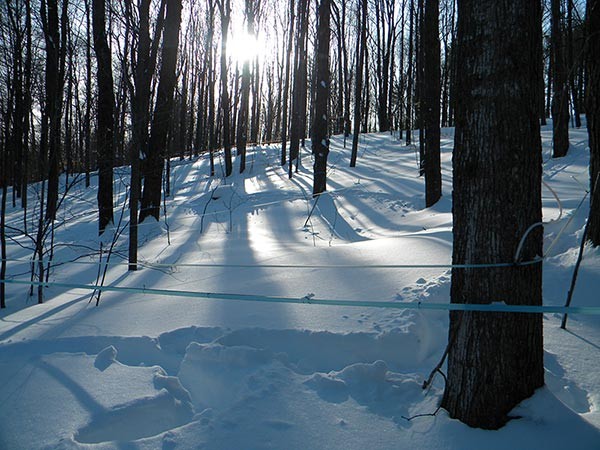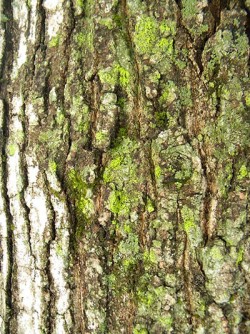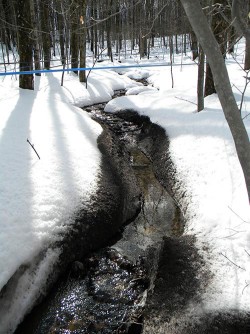As our sugaring operation grows, it gets harder to tell where one season ends and the next begins. From a production standpoint, last season ended on April 9, 2013, which is a logical place to draw a line. I’m smiling as I remember that day; the feeling of satisfaction we had gazing at the rows of full syrup drums. It had been, production wise, our best season ever.
But in the big picture, last April 9 was the end of a chapter, not the book. Once we’d stopped making syrup, we had to clean up, which entailed carrying water to every tree we’d tapped and letting the vacuum pump suck it through the drop line. We had to wash all the equipment, repair anything that needed fixing (including our relationships with our girlfriends and wives, who we’d only seen in passing for the previous two months). We had to get firewood cut and put up so it could cure, and, of course, had to start marketing and selling the product. By that stage, we were well into summer.
Then, in typical farmer fashion, we plowed the profits into new rolls of tubing and mainline, adding a bunch of new taps. We chipped away at this expansion on weekends and school breaks. Our friend Nate Cardinal is a student at Paul Smith’s College in the Adirondacks; when he’s home he helps us build infrastructure. This work went right up and through the (very brief) January thaw, and before we knew it it was February 1 – normally time to start tapping.
♦ ♦ ♦
This winter has been consistently cold, so when the calendar turned to February, there wasn’t a lot of urgency. Drilling holes in trees when it’s too cold can damage them, so we watched the weather carefully and picked our spots. I drilled my first hole on February 9, on a raw, gunmetal-gray afternoon when the mercury hovered around 20 degrees. I worked slowly, intentionally, getting 100 or so trees done and then calling it quits. I might have worked on fixing tubing, but when it’s that cold the plastic is stiff and hard to work with. On Thursday the 13th a ‘Nor’easter dumped a full two feet of fresh powder onto the foot-plus that was already out there – the kind of snow your snowshoes sink into. Afterwards, walking in the woods became floundering in the woods, and I was wishing I’d gotten more done ahead of time.
Friends and family came to the rescue, and we kept chipping away, concentrating on getting our 40-acre “Farm” bush tapped because it’s east-facing and runs early. We trudged from tree to tree, leaving porcupine-like furrows in the snow. The Farm sits on the Taconic mountains, and working in these woods is always a nostalgic affair, both personally nostalgic, in that I’ve tapped these trees since I was old enough to wield a hammer, but more generally nostalgic, too, as the trees are big and old and have been sharing their sap for generations. Seventy years ago these woods were sugared by Colonel Fairfax Ayers. If you look down in the photo gallery below you’ll see a couple old shots from March 1947, side by side with pictures taken from the same spot in March 2014. It’s astounding to me that these trees were so big back then. It doesn’t seem unlikely that that tree the guy’s hanging a bucket on was 100 years old – probably even older – which puts its birth back before the Civil War. Every sugarmaker feels a bond with their trees; for us, the bond’s especially strong with these old monarchs.
By Sunday, February 23, the Farm was mostly tapped – we don’t have a firm count, but it’s somewhere around 1,600 trees – and it had warmed up enough that we collected the first sap of the year. With highs in the 40s and lows in the 20s the temperatures were conducive to sap flow, but the trees were frozen and not quite feeling spring yet. We collected about 1,000 gallons of 1.4 percent sap from that run, a low number that, in layman’s terms, means that it takes about 61 gallons of sap to produce a gallon of syrup. We sweetened the pans on Sunday night, and made the first syrup of the year. On Monday the 24th, the temps dropped again, so we drained the evaporator in preparation for an extended cold snap. I don’t think the temperature has gotten above freezing since.
♦ ♦ ♦
Our attention then turned to the Hall bush, which sits on the Green Mountains, about 5 miles east of the Farm. It’s owned by the Hall family, who are kind enough to lease it to us. It’s been tapped for exactly eight years now, and I smile thinking that maybe 80 years from now someone will be able to take an old picture that I took and match it up to a tree that they’re tapping.
Hall’s a cold bush – north and west facing – and even after the brief warm-up the snowpack was thigh-deep. Thankfully, the snow hardened up with the cold temperatures, and walking with snowshoes became relatively easy. Early March sun is exponentially stronger than early February sun, so even though the air was still frigid, the tree bark was absorbing and reflecting heat and everything seemed warmer.
As we tapped and the drill bits pierced the trees wood chips spiraled out of the holes and blossomed as they hit the cold, dry air – little white flowers sprinkled on the dark tree bark, clinging to the moss and lichen.
Regardless of temperature, the high March sun prompts the woods to come alive. More birds. More tracks in the layers of gauzy snow that have coated the ground at regular intervals here over the last four months. The deer have been conspicuously absent – yarded up somewhere. But the squirrels have been out in force, so too the mesopredators. There was a big fisher track and a small fisher track and a bobcat last weekend; also a red fox who seemed to be covering the woods as thoroughly as we were. If we weren’t working I would have loved to follow his tracks and try to figure the meaning in his methodical meander.
Last Sunday morning there were five of us up in the woods, pulling lines up out of the snow, cutting in saddles to the new mainline, tapping. By this point we’d tapped around 3,000 trees, and the whole process had become rote. We decided to experiment with the new, clear, one-piece check valve spials in one section of the woods – everything else we have is two-piece. When I’d come to these one-piecers, I’d note them, but after drilling the hole I’d reflexively reach into my bag for a two piece and set it in the hole. It was a funny exercise in brain manipulation – the muscle memory trumping the visual stimulus.
As we worked we could hear the throaty roar of a skidder across the valley – Ed Legacy and his son Kyle were cutting beautiful oak sawlogs. This place where I live is changing: the landscape, the people, the culture. But here we were, seven of us in the woods, working the land like it’s been worked for the last 300 or 400 years. I was proud to be a link in that chain.
♦ ♦ ♦
So there’s where we are to date. The long-range forecast has it warming up a little bit today and tomorrow, but then cold again through Saint Patrick’s Day. There’s this line of thought that holds that cold, snowy winters portend a good sugaring season, but that’s just not true. The sap usually stops running in early April around here, so when a season is slow to start, it often means a reduced crop. Once it does warm up sugarmakers will be the only ones praying for mid-40s, cursing the strong April sun and the 50 and 60 degree temps that kill a season. It’s still too early to tell what’s going to happen, but suffice it to say we’re all getting a little nervous.
Let me know how you’re doing once you start making syrup. And good luck.











Discussion *